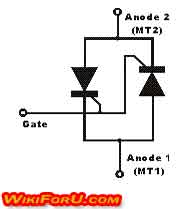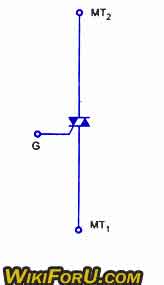A Triac is a three terminal bidirectional semiconductor switching device which can control alternating current in a load.
Triac word made from two words: 'Tri' and 'ac'. Where Tri means three and 'ac' means alternating current. Thus triac is a three terminal device which can control alternating current in a load.It is an abbreviation for a triode ac switch. It is a bidirectional device, that means it can conduct in both directions(for both half cycles:positive half cycle and negative half cycle) for a specific time period. That is why sometimes, it is also known as bidirectional semiconductor triode switch.
Also Read: LVDT Transducers - Theory & Applications
Construction of Triac:

Triac word made from two words: 'Tri' and 'ac'. Where Tri means three and 'ac' means alternating current. Thus triac is a three terminal device which can control alternating current in a load.It is an abbreviation for a triode ac switch. It is a bidirectional device, that means it can conduct in both directions(for both half cycles:positive half cycle and negative half cycle) for a specific time period. That is why sometimes, it is also known as bidirectional semiconductor triode switch.
Also Read: LVDT Transducers - Theory & Applications
Construction of Triac:

The construction of a Triac is shown in figure. This figure shows the basic construction of triac that a Triac is basically made by connecting two Silicon Controlled Rectifiers in inverse parallel combination with common gate. A triac is almost similar to an SCR , but Triac is a bidirectional device whereas SCR is a unidirectional device like Diode. The internal layers and doping is done in such a way that the current can flow in both directions. The figure shows the equivalent circuit. It clearly shows that a Triac is made by connecting two SCRs in inverse parallel combination and by making gate common.
Also Read: Construction and Working Of Keyboard Controller

Also Read: Magnetron - Construction and Working
Working Of Triac:
To understand the working of a Triac let us consider that we apply alternating current source across the terminals MT1 and MT2 (As shown in symbol). Now we connect a D.C. Source with gate through a switch that is kept open first. Now when the gate supply switch is open , there is no current flowing through gate, therefore the maximum value of alternating current is less than the breakover voltage of triac. Therefore the Triac will remain in OFF state and doesn't conduct.
When we close the switch key, the circuit becomes closed circuit and current starts flowing through gate. Now triac breaks and starts conducting heavily. Thus it works as closed switch. However, we can control the firing angle and breakdown voltage of triac by using gate current.











